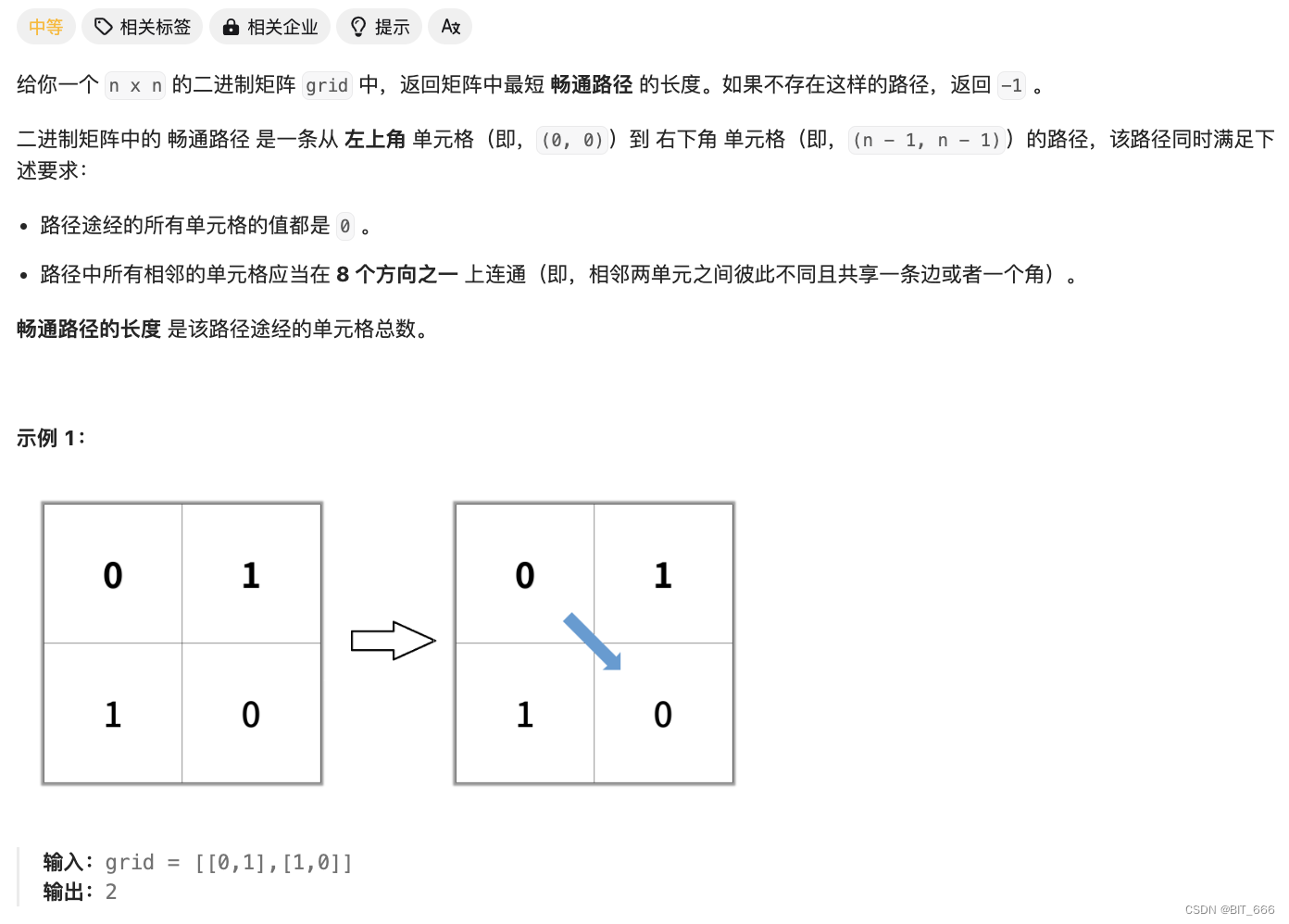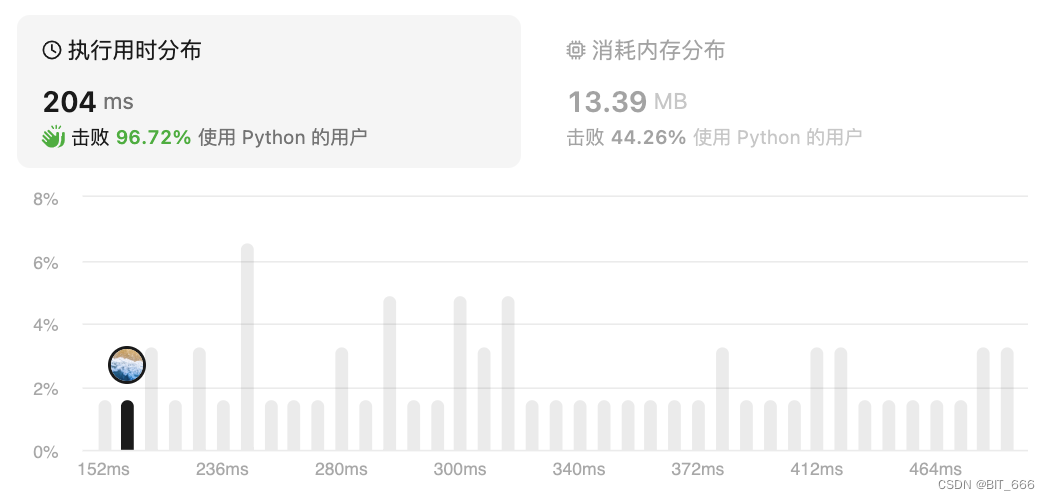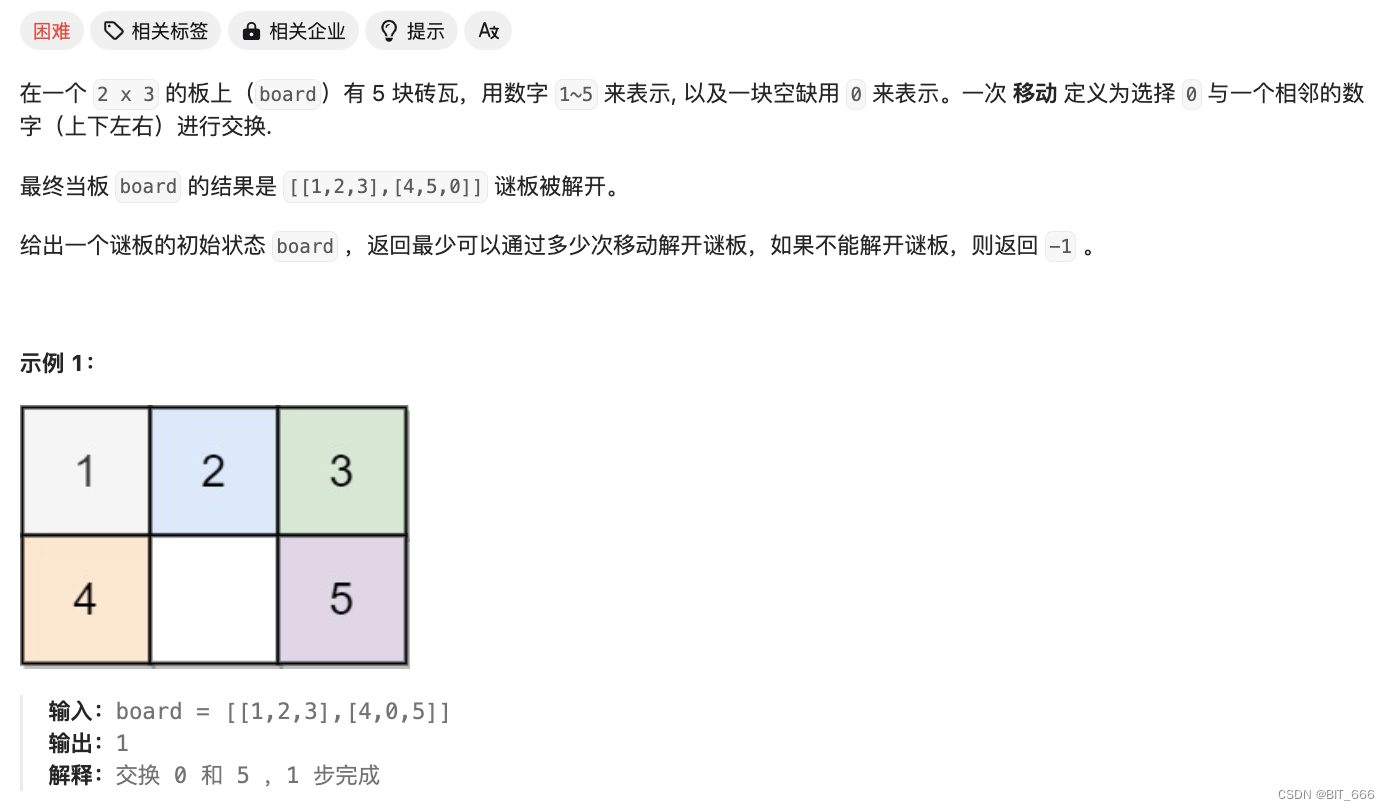目录
一.引言
二.启发式搜索简介
1.BFS 广度优先
2.A* Search
3.估价函数
三.经典算法实战
1.Binary-Shortest-Path [1091]
2.Sliding-Puzzle [773]
四.总结
一.引言
Heuristic Search 启发式搜索,又名 A* 搜索,其不基于广度、也不基于深度而是基于元素的优先级进行遍历搜索,不断优化搜索的方向提高搜索效率,下面我们看下启发式搜索的常用方式与算法例题。
二.启发式搜索简介
1.BFS 广度优先

2.A* Search

比起从 queue 里一个一个的顺序弹出,我们可以加入一些智能的元素,让弹出的元素使得搜索的方向更加优化,所以我们把 queue 替换成了 priotity_queue,而优先级的定义则需要我们根据实际问题构建一个估价函数 h(n)。
3.估价函数

上面的优先队列的评估标准需要基于 h(n),这个就是一个启发式的方法,其返回一个非负实数,我们可以认为返回的值越大,当前的节点相对于最终的结果搜索方向更优,即 h(n) 越大,元素优先级越高,越先遍历该元素。
三.经典算法实战
1.Binary-Shortest-Path [1091]
二进制最短路径: https://leetcode.cn/problems/shortest-path-in-binary-matrix

◆ 题目分析
根据 BFS 逐层遍历,当我们第一次到达终点时,也就是最短路径到达时。
◆ BFS
class Solution(object):def shortestPathBinaryMatrix(self, grid):""":type grid: List[List[int]]:rtype: int"""M = len(grid)if grid[0][0] == 1 or grid[M - 1][M - 1] == 1:return -1stack = [(0, 0, 1)]grid[0][0] = 1# 8联通direction = [(-1, -1), (-1, 0), (-1, 1), (0, -1), (0, 1), (1, -1), (1, 0), (1, 1)]while stack:row, col, step = stack.pop(0)# 终止条件if row == M - 1 and col == M - 1:return step# 8 连通图for dx, dy in direction:i, j = row + dx, col + dyif 0 <= i < M and 0 <= j < M and grid[i][j] == 0:grid[i][j] = 1stack.append((i, j, step + 1))return -1这里有的同学可能有疑问,明明8个方向,为什么直接就返回 step 了,下面提供两种思路:
A.广度优先每一层的行走距离是一样的,如果当前层率先走到终点,则其一定是最短的
B.我们对每个走过的点标为了 1,如果一个点需要先到这个标 1 的点再去终点,那么它一定没有标 1 这个点近。这个找了个示例,大家更好理解下,对于 [0,1] 位置,其可以走到 [0, 2] 和 [1, 2],如果先走 [0, 2] 再走 [1, 2] 到 [2, 2],那么一定没有 [1, 2] 到 [2, 2] 近。而标记过后我们也可以看出,[0, 2] 位置已经无路可走了,而 [1, 2] 还能走。
grid = [[0, 0, 0], => grid = [[1, 1, 1],[1, 1, 0], [1, 1, 1],[1, 1, 0]] [1, 1, 0]]
◆ A* x BFS
import heapqclass Solution(object):def shortestPathBinaryMatrix(self, grid):# 边界条件n = len(grid)if not grid or grid[0][0] == 1 or grid[n - 1][n - 1] == 1:return -1elif n <= 2:return n# 估价函数def heuristic(x, y):return max(abs(n - 1 - x), abs(n - 1 - y))h = []direction = [(-1, -1), (-1, 0), (-1, 1), (0, -1), (0, 1), (1, -1), (1, 0), (1, 1)]# (val, (row, col, step))heapq.heappush(h, (0, (0, 0, 1)))while h:_, (row, col, step) = heapq.heappop(h)# 遍历点标记if grid[row][col] == 1:continuegrid[row][col] = 1for dx, dy in direction:i, j = row + dx, col + dyif i == n - 1 and j == n - 1:return step + 1if 0 <= i < n and 0 <= j < n and grid[i][j] == 0:# 估价函数为 步数 + 距离 最小即最短路径heapq.heappush(h, (step + heuristic(i, j), (i, j, step + 1)))return -1heapq 是小根堆,所以我们的估价函数需要满足距离越近值越小,从而越先遍历近的点,上面的 L1 曼哈顿距离满足相距越近距离越小。

2.Sliding-Puzzle [773]
滑动谜题: https://leetcode.cn/problems/sliding-puzzle/description/

◆ 题目分析
这个题可以将 2x3 网格转换一个 len = 6 的字符串,然后每次遍历 0 可以交换的位置,依次 BFS 直到达到 012345 的状态,所以本题就可以转换为一个字符接龙的问题,可以回看前面双向 BFS 的章节。
◆ BFS
class Solution(object):def slidingPuzzle(self, board):""":type board: List[List[int]]:rtype: int"""# 记录下一次可走的位置moves = {0: [1, 3],1: [0, 2, 4],2: [1, 5],3: [0, 4],4: [1, 3, 5],5: [2, 4]}used = set()cnt = 0s = "".join(str(c) for row in board for c in row)# 格子以及0的位置q = [(s, s.index("0"))]while q:new = []for s, i in q:used.add(s)if s == "123450":return cntarr = [c for c in s]for move in moves[i]:new_arr = arr[:]new_arr[i], new_arr[move] = new_arr[move], new_arr[i]new_s = "".join(new_arr)if new_s not in used:new.append((new_s, move))cnt += 1q = newreturn -1
◆ 双向 BFS
class Solution(object):def slidingPuzzle(self, board):""":type board: List[List[int]]:rtype: int"""moves = {0: [1, 3],1: [0, 2, 4],2: [1, 5],3: [0, 4],4: [1, 3, 5],5: [2, 4]}used = set()cnt = 0s = "".join(str(c) for row in board for c in row)# 格子以及0的位置front = [s]back = ["123450"]while front and back:new = []for s in front:used.add(s)index = s.index("0")# 相遇了if s in back:return cntarr = [c for c in s]for move in moves[index]:new_arr = arr[:]new_arr[index], new_arr[move] = new_arr[move], new_arr[index]new_s = "".join(new_arr)if new_s not in used:new.append(new_s)cnt += 1if len(new) > len(back):front, back = back, newelse:front = newreturn -1套用单词接龙模版,直接双向 BFS 即可。

◆ A* x BFS
import heapq
M, N = 2, 3class Solution:def slidingPuzzle(self, board):def h(s):dist = 0s2 = "123450"i1 = s.index("0")i2 = s2.index("0")x1, y1 = i1 % N, i1 // Nx2, y2 = i2 % N, i2 // Ndist += abs(x1 - x2) + abs(y1 - y2)return distend_state = "123450"board = board[0] + board[1]s = "".join(str(c) for c in board)moves = [(1, 3), (0, 2, 4), (1, 5), (0, 4), (1, 3, 5), (2, 4)]visited = set()q = [] step = 0heapq.heappush(q, (h(s) + step, s, step))while q:sample = heapq.heappop(q)state, step = sample[1], sample[2]if state == end_state:return stepnow = state.index('0')for next0 in moves[now]:_state = list(state)_state[next0], _state[now] = _state[now], _state[next0]_state = "".join(_state)if _state not in visited: heapq.heappush(q, (h(_state) + step + 1, _state, step + 1))visited.add(state)return -1和上面同理,把无脑 append + pop 改成使用 headq 进行 push 和 pop,距离采用曼哈顿距离计算, 这里由于网格 M/N 的大小比较小,所以 BFS 会比 A* 快一些,如果网格的增加,A* 会逐渐体现出其优势。

四.总结
根据场景的不同,我们可以选择 BFS -> 双向 BFS -> A* Search + h(n) -> 双向 A* Search + h(n),这里 A* 主要区别在于估价函数的选择,下面链接了给出了常用的五种距离函数,对于我们常见的二维网格 + 抵达终点的情况,我们一般使用曼哈顿距离即可。
A* 常用距离函数: https://dataaspirant.com/five-most-popular-similarity/



:windows 下进程同步)







Vary: Scaling up the Vision Vocabulary for Large Vision-Language Models)





)

)
